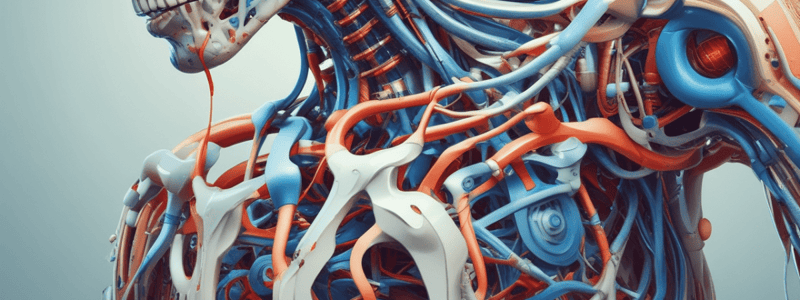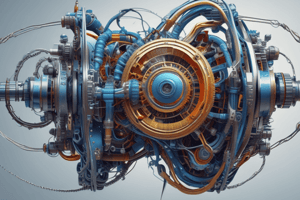Podcast
Questions and Answers
Internal forces are generated by structures located outside the body.
Internal forces are generated by structures located outside the body.
False (B)
External forces originate from gravity, external loads, or physical contact.
External forces originate from gravity, external loads, or physical contact.
True (A)
Newton's laws of motion are not relevant to understanding human movement analysis.
Newton's laws of motion are not relevant to understanding human movement analysis.
False (B)
The internal and external forces typically act in opposite linear directions, so they produce in similar rotary directions.
The internal and external forces typically act in opposite linear directions, so they produce in similar rotary directions.
Active forces are generated by stimulated muscles under voluntary control.
Active forces are generated by stimulated muscles under voluntary control.
The second-class lever in the musculoskeletal system has 3 features.
The second-class lever in the musculoskeletal system has 3 features.
$F = ma$ is not one of Newton's laws of motion.
$F = ma$ is not one of Newton's laws of motion.
In a second-class lever, the muscle (the internal force) possesses greater leverage than the external force.
In a second-class lever, the muscle (the internal force) possesses greater leverage than the external force.
Passive forces are generated by tension in stretched connective tissues.
Passive forces are generated by tension in stretched connective tissues.
In a third-class lever, the external weight supported always has greater leverage than the muscle force.
In a third-class lever, the external weight supported always has greater leverage than the muscle force.
The third-class lever is the least common lever in the musculoskeletal system.
The third-class lever is the least common lever in the musculoskeletal system.
The force components vector resolution process is the replacement of a single force with two or more forces that when combined are equivalent to the original force.
The force components vector resolution process is the replacement of a single force with two or more forces that when combined are equivalent to the original force.
When the muscle angle α is 20 °, the X component force is smaller than the Y component force.
When the muscle angle α is 20 °, the X component force is smaller than the Y component force.
At an angle of 45 °, the X and Y components of muscle force have equal magnitude.
At an angle of 45 °, the X and Y components of muscle force have equal magnitude.
An α of 90 ° results in all muscle force being directed in the Y direction to produce a flexion torque.
An α of 90 ° results in all muscle force being directed in the Y direction to produce a flexion torque.
Changing the muscle angle to less than or equal to 90° results in an X component force directed towards the joint, creating a compression force.
Changing the muscle angle to less than or equal to 90° results in an X component force directed towards the joint, creating a compression force.
The internal torque at the elbow is mainly influenced by the MX component.
The internal torque at the elbow is mainly influenced by the MX component.
External forces that are pointed in the +X direction tend to compress the joint.
External forces that are pointed in the +X direction tend to compress the joint.
Muscles that work in concert to produce a moment always have identical magnitudes and orientations.
Muscles that work in concert to produce a moment always have identical magnitudes and orientations.
Friction can prevent the motion of an object when it is at rest.
Friction can prevent the motion of an object when it is at rest.
Kinetic friction is always greater than static friction.
Kinetic friction is always greater than static friction.
It would take less force to keep an object moving than it would take to start it moving.
It would take less force to keep an object moving than it would take to start it moving.
Increasing the normal or perpendicular forces pressing two objects together will decrease static friction.
Increasing the normal or perpendicular forces pressing two objects together will decrease static friction.
Friction is always more difficult to initiate dragging an object across a surface than to continue dragging.
Friction is always more difficult to initiate dragging an object across a surface than to continue dragging.
Forces acting on a body have two components: a rotational component and a linear (translatory) component.
Forces acting on a body have two components: a rotational component and a linear (translatory) component.
According to Newton's first law, a body in constant linear velocity will remain in that state unless compelled by an external force.
According to Newton's first law, a body in constant linear velocity will remain in that state unless compelled by an external force.
A body in dynamic equilibrium has zero acceleration but non-zero velocity.
A body in dynamic equilibrium has zero acceleration but non-zero velocity.
The center of mass (CoM) and the center of gravity (CoG) of a body are always the same point.
The center of mass (CoM) and the center of gravity (CoG) of a body are always the same point.
Newton's first law describes the case where a body is in static equilibrium.
Newton's first law describes the case where a body is in static equilibrium.
The inertia of a body is inversely proportional to its mass.
The inertia of a body is inversely proportional to its mass.




